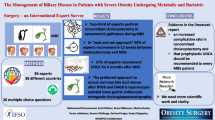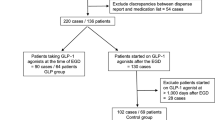Abstract
Background
Before bariatric surgery, the necessity of routine upper gastrointestinal endoscopy is controversial, and guidelines recommend endoscopy in symptomatic cases. However, impaired visceral sensation occurring in obese patients may be misleading. The purpose of the study is to evaluate prospectively the prevalence of gastrointestinal symptoms, endoscopic findings, and the relation between symptoms and endoscopic findings in obese patients before surgery.
Materials and Methods
One hundred forty-two consecutive patients candidate to primary bariatric surgery filled out the validated Rome III symptomatic questionnaire and performed endoscopy.
Results
With a median age of 41 years and BMI of 44 Kg/m2, 83 % were females. Symptoms were referred by 43 % of patients: gastroesophageal reflux disease (GERD) (27.9 %) and dyspepsia (24.6 %), subdivided in postprandial distress (PDS) (66.7 %) and epigastric pain (33.3 %) syndromes. Of GERD patients, 19.7 % presented concomitantly PDS. Belching was present in 8.2 % and nausea and/or vomiting in 1.6 % of patients. At endoscopy, one or more lesions were present in 47.1 % of the patients: erosive esophagitis (5.6 %), hiatal hernia (23.2 %), gastroduodenal erosions (6.3 %), and peptic ulcers (3.5 %). At histology, 24 % of patients have Helicobacter pylori infection, and its prevalence in gastroduodenal erosions and ulcers was 22.2 and 60 %, respectively. Surprisingly, in patients with peptic lesions H. pylori-negative, no chronic use of NSAIDs was reported. Analyzing the coexistence of symptoms and lesions, these resulted equally distributed beyond the presence of symptoms, being present in 44.2 and 49.4 % of symptomatic and asymptomatic patients, respectively.
Conclusions
The presence of symptoms cannot be considered as a valuable guide to indicate endoscopy since the majority of endoscopic lesions were asymptomatic and not H. pylori-related.

Similar content being viewed by others
References
Mechanick JI, Youdim A, Jones DB, Garvey WT, Hurley DL, McMahon MM, et al. American Association of Clinical Endocrinologists; Obesity Society; American Society for Metabolic & Bariatric Surgery. Clinical practice guidelines for the perioperative nutritional, metabolic, and nonsurgical support of the bariatric surgery patient—2013 update: cosponsored by American Association of Clinical Endocrinologists, The Obesity Society, and American Society for Metabolic & Bariatric Surgery. Obesity. 2013;Suppl 1:S1–27. PMID: 23529939.
Fried M, Yumuk V, Oppert JM, Scopinaro N, Torres AJ, Weiner R, et al. European Association for the Study of Obesity; International Federation for the Surgery of Obesity - European Chapter. Interdisciplinary European guidelines on metabolic and bariatric surgery. Obes Facts. 2013;6(5):449–68. PMID: 24135948.
Korenkov M, Sauerland S, Shah S, Junginger T. Is routine preoperative upper endoscopy in gastric banding patients really necessary? Obes Surg. 2006;16(1):45–7. PMID: 16417757.
Sharaf RN, Weinshel EH, Bini EJ, Rosenberg J, Sherman A, Ren CJ. Endoscopy plays an important preoperative role in bariatric surgery. Obes Surg. 2004;14(10):1367–72. PMID: 15603653.
Azagury D, Dumonceau JM, Morel P, Chassot G, Huber O. Preoperative work-up in asymptomatic patients undergoing Roux-en-Y gastric bypass: is endoscopy mandatory? Obes Surg. 2006;16(10):1304–11. PMID: 17059738.
Küper MA, Kratt T, Kramer KM, Zdichavsky M, Schneider JH, Glatzle J, et al. Effort, safety, and findings of routine preoperative endoscopic evaluation of morbidly obese patients undergoing bariatric surgery. Surg Endosc. 2010;24(8):1996–2001. PMID: 20135170.
Koppman JS, Poggi L, Szomstein S, Ukleja A, Botoman A, Rosenthal R. Esophageal motility disorders in the morbidly obese population. Surg Endosc. 2007;21(5):761–4. PMID: 17285388.
Côté-Daigneault J, Leclerc P, Joubert J, Bouin M. High prevalence of esophageal dysmotility in asymptomatic obese patients. Can J Gastroenterol Hepatol. 2014;28(6):311–4. PMID: 24945185.
Greenstein RJ, Nissan A, Jaffin B. Esophageal anatomy and function in laparoscopic gastric restrictive bariatric surgery: implications for patient selection. Obes Surg. 1998;8(2):199–206. PMID: 9730394.
Ganesh R, Rao AD, Leese T, Baladas HG. Laparoscopic adjustable gastric banding in a patient with an incidental para-hiatal hernia. Obes Surg. 2006;16(1):98–101. PMID: 16417766.
Chang CG, Perez E. Case reports—resolution of Barrett’s disease and esophageal epithelial atypia after gastric bypass and LAP-BAND. Obes Surg. 2009;19(11):1597–8. PMID: 19756886.
Tack J, Talley NJ, Camilleri M, Holtmann G, Hu P, Malagelada JR, et al. Functional gastroduodenal disorders. Gastroenterology. 2006;130(5):1466–79. PMID: 16678560.
Vakil N, van Zanten SV, Kahrilas P, Dent J, Jones R, Global Consensus Group. The Montreal definition and classification of gastroesophageal reflux disease: a global evidence-based consensus. Am J Gastroenterol. 2006;101(8):1900–20. PMID: 16928254.
Lundell LR, Dent J, Bennett JR, Blum AL, Armstrong D, Galmiche JP, et al. Endoscopic assessment of oesophagitis: clinical and functional correlates and further validation of the Los Angeles classification. Gut. 1999;45(2):172–80. PMID: 10403727.
American Diabetes Association. Standards of medical care in diabetes—2014. Diabetes Care. 2014;Suppl 1:S14–80. PMID: 24357209.
Loewen M, Giovanni J, Barba C. Screening endoscopy before bariatric surgery: a series of 448 patients. Surg Obes Relat Dis. 2008;4(6):709–12. PMID: 18514584.
Rosenthal RJ, International Sleeve Gastrectomy Expert Panel, Diaz AA, Arvidsson D, Baker RS, Basso N, et al. International Sleeve Gastrectomy Expert Panel Consensus Statement: best practice guidelines based on experience of >12,000 cases. Surg Obes Relat Dis. 2012;8(1):8–19. PMID: 22248433.
Li JF, Lai DD, Lin ZH, Jiang TY, Zhang AM, Dai JF. Comparison of the long-term results of Roux-en-Y gastric bypass and sleeve gastrectomy for morbid obesity: a systematic review and meta-analysis of randomized and nonrandomized trials. Surg Laparosc Endosc Percutan Tech. 2014;24(1):1–11. PMID: 24487151.
Humphreys LM, Meredith H, Morgan J, Norton S. Detection of asymptomatic adenocarcinoma at endoscopy prior to gastric banding justifies routine endoscopy. Obes Surg. 2012;22(4):594–6. PMID:21887608.
Zeni TM, Frantzides CT, Mahr C, Denham EW, Meiselman M, Goldberg MJ, et al. Value of preoperative upper endoscopy in patients undergoing laparoscopic gastric bypass. Obes Surg. 2006;16(2):142–6. PMID: 16469214.
de Moura Almeida A, Cotrim HP, Santos AS, Bitencourt AG, Barbosa DB, Lobo AP, et al. Preoperative upper gastrointestinal endoscopy in obese patients undergoing bariatric surgery: is it necessary? Surg Obes Relat Dis. 2008;4(2):144–9. PMID: 18294926.
Csendes A, Burgos AM, Smok G, Beltran M. Endoscopic and histologic findings of the foregut in 426 patients with morbid obesity. Obes Surg. 2007;17(1):28–34. PMID: 17355765.
Peromaa-Haavisto P, Victorzon M. Is routine preoperative upper GI endoscopy needed prior to gastric bypass? Obes Surg. 2013;23(6):736–9. PMID: 23585025.
Dietz J, Ulbrich-Kulcynski JM, Souto KE, Meinhardt NG. Prevalence of upper digestive endoscopy and gastric histopathology findings in morbidly obese patients. Arq Gastroenterol. 2012;49(1):52–5. PMID: 22481686.
Long E, Beales IL. The role of obesity in oesophageal cancer development. Ther Adv Gastroenterol. 2014;7(6):247–68. PMID: 25364384.
Carabotti M, Severi C, Leonetti F, De Angelis F, Iorio O, Corazziari E, et al. Upper gastrointestinal symptoms in obese patients and their outcomes after bariatric surgery. Expert Rev Gastroenterol Hepatol. 2013;7(2):115–26. PMID: 23363261.
Santonicola A, Angrisani L, Ciacci C, Iovino P. Prevalence of functional gastrointestinal disorders according to Rome III criteria in Italian morbidly obese patients. Sci World J. 2013;2013:532503. PMID: 24302861.
Fysekidis M, Bouchoucha M, Bihan H, Reach G, Benamouzig R, Catheline JM. Prevalence and co-occurrence of upper and lower functional gastrointestinal symptoms in patients eligible for bariatric surgery. Obes Surg. 2012;22(3):403–10. PMID: 21503810.
Tilg H, Moschen AR. Visceral adipose tissue attacks beyond the liver: esophagogastric junction as a new target. Gastroenterology. 2010;139(6):1823–6. PMID: 20977875.
Carabotti M, D'Ercole C, Iossa A, Corazziari E, Silecchia G, Severi C. Helicobacter pylori infection in obesity and its clinical outcome after bariatric surgery. World J Gastroenterol. 2014;20(3):647–53. PMID: 24574738.
Acknowledgments
We thank Mariana Ridolfi for her helpful collaboration in collection of data. Grant was received from the University of Rome Sapienza (2013).
Conflict of Interest
The authors declare that they have no competing interests.
Statement of Informed Consent
Informed consent was obtained from all individual participants included in the study.
Statement of Human and Animal Rights
All procedures performed in studies involving human participants were in accordance with the ethical standards of the institutional and/or national research committee and with the 1964 Helsinki declaration and its later amendments or comparable ethical standards.
Author information
Authors and Affiliations
Corresponding author
Additional information
G. Silecchia and C. Severi are the principal investigators.
Rights and permissions
About this article
Cite this article
Carabotti, M., Avallone, M., Cereatti, F. et al. Usefulness of Upper Gastrointestinal Symptoms as a Driver to Prescribe Gastroscopy in Obese Patients Candidate to Bariatric Surgery. A Prospective Study. OBES SURG 26, 1075–1080 (2016). https://doi.org/10.1007/s11695-015-1861-x
Published:
Issue Date:
DOI: https://doi.org/10.1007/s11695-015-1861-x




